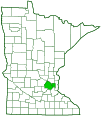Texas leaf-cutter bee
(Megachile texana)
Conservation • Description • Habitat • Ecology • Distribution • Taxonomy
Conservation Status |
|||
| IUCN Red List | not listed |
||
| NatureServe | NNR - Unranked SNR - Unranked |
||
| Minnesota | not listed |
||
Description |
Texas leaf-cutter bee is a chunky-looking, moderate-sized, solitary, leaf-cutting bee. It is common and widespread across the United States, in adjacent Canadian provinces, and in Mexico. It is uncommon, or at least little reported, in Minnesota. Females are robust and 7 ⁄16″ to 9 ⁄16″ (11 to 14 mm) long. The head is matte black. There are two large compound eyes, one on each side of the head; and three small simple eyes (ocelli) in a triangular pattern at the top of the head between the compound eyes. The area behind and below each compound eye (gena) is narrower than the compound eye. The sides of the face (paraocular area) and the area at the base of the antennae are densely covered with short whitish hairs. The gena is also covered with whitish hairs, dense and short at the bottom, becoming sparser and shorter toward the top. The top of the head (vertex) is covered with black hairs. The mandibles have 4 teeth and are very large, sometimes described as “enormous”. The large size allows them to be used for chewing leaves, gnawing wood, and moving small stones. The tongue is long and slender. The antennae are thread-like and are not elbowed. They have 12 segments. The thorax (mesosoma) has three segments. However, the first segment of the abdomen is fused to the thorax, giving the thorax the appearance of having four segments. The upper side of the thorax is matte black and densely pitted. It is covered with short, whitish hairs at the front and sides, black hairs on most of the middle, and some whitish hairs at the rear. The small plate covering the base of each forewing (tegula) is black. The abdomen is matte black and densely and finely pitted. There are six hardened plates (tergites) on the upper (dorsal) portion of the abdomen. The second through fifth tergites (T2 through T5) have a narrow, very dense fringe of short, whitish, rear-facing hairs, giving the abdomen a narrowly striped appearance. T1 is similar but mostly pale and some black hairs. T6 is distinctly concave when viewed from the side. The underside of the abdomen is densely covered with long, branched, electrostatically charged hairs (scopa) used for collecting pollen. On the female, the scopa are entirely yellowish-white on segments 2 through 4, yellowish-white at the base with black tips on segment 5, and entirely black on segment 6. The wings are semitransparent and have black veins. The broad lobe at the base of the hindwing (jugal lobe) is shorter than the narrow lobe adjacent to it (submedian lobe). The legs are black. Unlike most bees, there are no scopa on the hind legs. The last part of the leg (tarsus), beyond the fourth segment (tibia) and corresponding to the foot, has three sections. On the middle and hind legs the first section (basitarsus) is nearly as long and broad as the tibia. Males are a little smaller than females, ⅜″ to ½″ (10 to 12 mm) long. The mandibles have only 3 teeth. The hairs on the lower part of the gena are snowy-white, longer, and more abundant than on the female. The fringe of whitish hairs on T1 through T5 is dense at the sides, becoming shorter, sparser, and interrupted in the middle. The basitarsus on all legs is slender and shorter than the tibia. |
Size |
Male: ⅜″ to ½″ (10 to 12 mm) Female: 7 ⁄16″ to 9 ⁄16″ (11 to 14 mm) |
Similar Species |
Habitat |
|
Ecology |
Season |
|
Behavior |
|
Life Cycle |
Texas leaf-cutter bee is a solitary bee. It does not nest in hives. The female builds a tubular nest, usually in an existing crevice, often near other nests but never sharing an entrance. She cuts circular disks of leaves, about 1″ in diameter, placing about 15 of them at the bottom of the first cell. She then provisions the cell with pollen and regurgitated nectar, and lays a single egg. She then seals the cell with more leaf disks. She continues this process until she has laid 18 to 25 or more eggs. The larvae undergo four instar stages. Some will emerge as adults later in the summer. Others will enter a pre-pupal, hibernation-like phase (diapause), overwinter, pupate in the spring, and emerge as adults the following summer. |
Larva Food |
Flower nectar and pollen |
Adult Food |
Texas leaf-cutter bee is a food generalist. It eats pollen and nectar from more than 80 different species of plants. |
Distribution |
||
|
Sources Biodiversity occurrence data published by: Minnesota Biodiversity Atlas (accessed through the Minnesota Biodiversity Atlas Portal, bellatlas.umn.edu, XX/XX/XXXX). |
|
| 8/28/2025 | ||
Occurrence |
||
|
||
Taxonomy |
|
Order |
Hymenoptera (Ants, Bees, Wasps, and Sawflies) |
Suborder |
Apocrita (Narrow-waisted Wasps, Ants, and Bees) |
Infraorder |
Aculeata (Ants, Bees, and Stinging Wasps) |
Superfamily |
Apoidea (Bees and Apoid Wasps) |
| Epifamily | Anthophila (bees) |
Family |
Megachilidae (mason, leafcutter, carder, and resin bees) |
Subfamily |
Megachilinae |
Tribe |
Megachilini |
Genus |
Megachile (leaf-cutter, mortar, and resin bees) |
| Subgenus | Litomegachile |
The genus name Megachile means “large lipped”, and refers to the very large mandibles. |
|
Subordinate Taxa |
|
|
|
Synonyms |
|
Megachile cleomis Megachile generosa Megachile pruinosa Megachile schismatura Megachile vernonensis |
|
Common Names |
|
Texas leafcutter Texas leafcutter bee Texas leaf-cutter bee |
|
Glossary
Gena
In insects, the area behind and below the compound eye. In birds, the feathered side (outside) of the under mandible; the area between the the angle of the jaw and the bill.
Diapause
A period of decreased metabolic activity and suspended development.
Ocellus
Simple eye; an eye with a single lens. Plural: ocelli.
Scopa
A brush-like tuft of hairs on the legs or underside of the abdomen of a bee used to collect pollen.
Tarsus
On insects, the last two to five subdivisions of the leg, attached to the tibia; the foot. On spiders, the last segment of the leg. Plural: tarsi.
Tegula
A small, hardened, plate, scale, or flap-like structure that overlaps the base of the forewing of insects in the orders Lepidoptera, Hymenoptera, Diptera, and Homoptera. Plural: tegulae.
Tergite
The upper (dorsal), hardened plate on a segment of the thorax or abdomen of an arthropod. Plural: terga.
Tibia
The fourth segment of an insect leg, after the femur and before the tarsus (foot). The fifth segment of a spider leg or palp. Plural: tibiae.
Vertex
The upper surface of an insect’s head.
Visitor Photos |
Share your photo of this insect. |
||
This button not working for you? |
||
Norm & Peg Dibble |
||
On 08/3/2019 there were several types of bees or wasps on our large bush of Swamp Milkweed. This very small black and white striped bee (unfamiliar to me) was very difficult to photograph. He was moving constantly and too small for the camera to focus before he was off to another flower cluster, but here are two of the best shots I got. One shows his body stripes well and the other shows his head and eye better. |
||
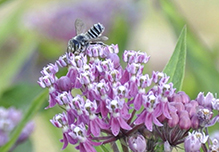 |
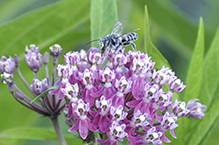 |
|
I went back out this afternoon to find the white bee again and it was there along with many others and one Monarch. It was difficult to get the bee photo from head on. |
||
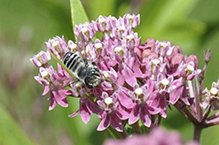 |
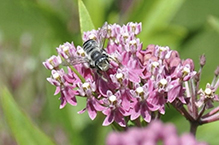 |
|
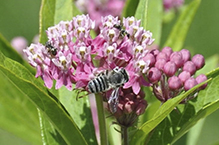 |
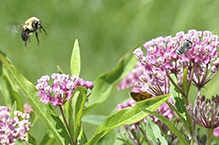 |
|
MinnesotaSeasons.com Photos |
|

Slideshows |
Title |

Visitor Videos |
Share your video of this insect. |
||
This button not working for you? |
||
|
Other Videos |
|

Visitor Sightings |
Report a sighting of this insect. |
||
This button not working for you? |
||
MinnesotaSeasons.com Sightings |
|

|
Created: 8/21/2019 Last Updated: © MinnesotaSeasons.com. All rights reserved. |
